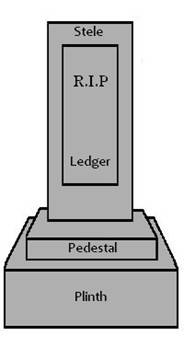Gravesites are fascinating places, brimming with history, stories, and sometimes, a bit of mystery. If you’ve ever ambled through a cemetery, you might have noticed various elements adorning the graves. Among the headstones, statues, and flowers, there’s one piece that often goes unnoticed but plays a crucial role: the grave plinth. So, what is a grave plinth? Let’s delve in and find out!
Hey there! Ever found yourself meandering through an old cemetery, soaking in the peaceful atmosphere and the intriguing details on the gravestones? Amid the angels, crosses, and inscriptions, you might have spotted something called a grave plinth. It’s not as common a term as a headstone or a tombstone, but it’s just as important. Let’s uncover what a grave plinth is and why it matters.
Defining a Grave Plinth
A grave plinth is essentially the base or foundation upon which a headstone or monument is perched. Think of it as the pedestal that supports and elevates the main memorial. It’s usually crafted from the same material as the headstone, like granite or marble, and it serves both a practical and aesthetic purpose.
The Practical Purpose of a Grave Plinth
First off, let’s talk about the practical side. A grave plinth provides stability. By giving the headstone a solid base, it helps keep everything upright and anchored, even through bad weather or the passage of time. Without a sturdy plinth, headstones might start to tilt or sink into the ground, which would be a bit of a downer when visiting a loved one’s final resting place.
Aesthetic and Symbolic Significance
Now, onto the aesthetic and symbolic side of things. Grave plinths add a touch of elegance and grandeur to the memorial. They can elevate the headstone, making it more prominent and easier to read. Plus, they often showcase additional engravings or decorations, enhancing the overall beauty of the site.
Different Styles and Materials
Grave plinths come in all sorts of shapes and sizes. Some are simple and unadorned, while others are more elaborate, featuring intricate carvings or inscriptions. The material is usually chosen to match the headstone, but you might see variations depending on the style and era. Granite and marble are popular choices because they’re durable and visually appealing.
Historical and Cultural Context
Historically, grave plinths have been utilized in various cultures and times. In ancient Egypt, for example, they had elaborate bases for their tombs, often embellished with hieroglyphics. In more recent times, Victorian cemeteries boasted grand plinths with detailed carvings and inscriptions, reflecting the era’s emphasis on memorialization.

Modern Uses and Trends
These days, you’ll find grave plinths in modern cemeteries too. They’re still used to support headstones, but they also offer a way to personalize the grave. Families might choose a specific design, material, or inscription to reflect the personality and preferences of their loved one. It’s a way to make the memorial unique and meaningful.
How to Choose a Grave Plinth
If you’re in the process of selecting a grave plinth, there are a few things to consider. First, think about the material. Granite and marble are sturdy choices, but there are other options too. Next, contemplate the design. Do you want something simple or more ornate? Finally, ponder any additional inscriptions or decorations. This is your chance to add a personal touch to the memorial.
Maintaining a Grave Plinth
Like any part of a gravesite, a grave plinth needs some maintenance to keep it looking its best. Regular cleaning with gentle, non-abrasive cleaners will help prevent staining and weathering. If you notice any cracks or damage, it’s a good idea to get it repaired sooner rather than later to avert further issues.
FAQs
What exactly is a grave plinth?
A grave plinth is the base or foundation that supports a headstone or monument. It provides stability and can also augment the aesthetic appeal of the memorial.
Why is a grave plinth important?
Grave plinths are important because they provide stability, preventing the headstone from tilting or sinking. They also enhance the appearance of the grave, making it more prominent and easier to read.
What materials are used for grave plinths?
Common materials for grave plinths include granite and marble, chosen for their durability and appearance. Other materials can be used as well, depending on personal preferences and cemetery regulations.
Can a grave plinth be personalized?
Yes, grave plinths can be personalized with inscriptions, carvings, and designs that reflect the personality and preferences of the deceased or their family.
How do you maintain a grave plinth?
Regular cleaning with gentle cleaners will help maintain a grave plinth. It’s also important to address any cracks or damage promptly to prevent further deterioration.
Do all graves have plinths?
Not all graves have plinths. The presence of a plinth depends on the design of the memorial and the preferences of the family. Some graves might have headstones without a plinth, while others feature elaborate bases.
So, there you have it – the lowdown on grave plinths. These sturdy bases might not get all the attention, but they play a crucial role in keeping headstones standing tall and looking good. Next time you’re wandering through a cemetery, take a moment to appreciate these unsung heroes of the memorial world. They might be the foundation, but they sure do make a grave site stand out.

